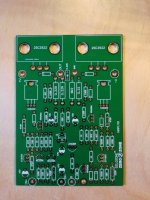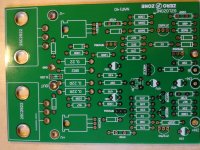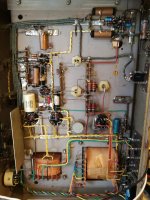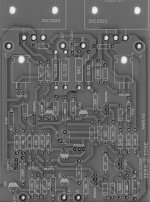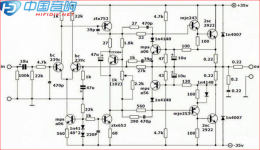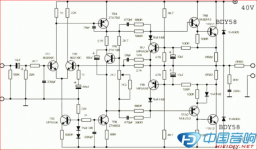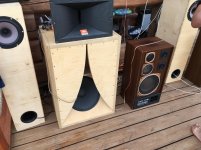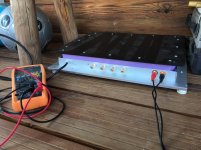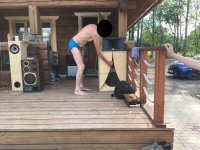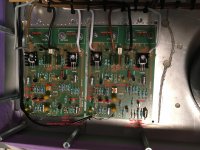No,
But i experienced with custom made trought USB converting, i can't comment on that cuz i wasn't using them.
Tought... i have experienced lots of laptop integrated soundcards 😀 Was selling them alot few years ago😛
None of them were good, they lacked a little bit of everything😀
But i experienced with custom made trought USB converting, i can't comment on that cuz i wasn't using them.
Tought... i have experienced lots of laptop integrated soundcards 😀 Was selling them alot few years ago😛
None of them were good, they lacked a little bit of everything😀
Yesterday I packed the card and I had a good surprise. It is not the pcb that I ordered, but it is better and of very good quality. I'll do some pictures tonight
you'll get the links to Aliexpress and Ebay stores and maybe the NAP 200 pages in this thread too, if you care to read the earlier findings and construction ideas for the kits.
I've read through most of this thread but unfortunately any links referencing the Caowei kits have been long extinct.
If you Google "Caowei black box NAP200 kit"
Black Box のClone Naim NAP200 Amplifier kit Diy Power amp kit 75W+75W 4650016144531 | eBay
This one doesn't say Caowei - can you tell me if this is similar quality to the Caowei kits that you refer to?[/QUOTE]
i think,caowei is down :/
I think you might be right...
for the rest, the most important is to take the time to read the information, that's what makes the difference between a transistor amp and a piece of happiness in everyday life
Well said!
Hi again
I realized that unless you use similar search terms a lot, you only get a few URL's when you Google new terms. I got about 16 when I checked for the kit but some weren't current.
Scroll down to the assembly pics linked above. The first pic has the CAOWEI brand showing beneath the index finger of the hand you see. ZeroZone's PCB is, I believe, a direct photo reproduction of Caowei's which in turn, is taken directly from Naim's board. They are both alleged drop-in replacements for Naim's so the board is not likely to be an issue. Otherwise, the silk screen markings are distinctly thicker on ZeroZone product and their logo is hard to miss. It seems common for Chinese sellers to simply copy other sellers pics, logos, watermarks etc. just to get attractive illustrations easily. It's shameless piracy from our POV but I guess if they can't read the English text, it may not matter to them.
The following pics also show Along1986090's Caowei board and the original Naim amplifier PCB view for comparison. The Caowei board was all that was available when posted earlier. However, Along's current offering is the Zero Zone kit, probably because it's significantly cheaper and more competitive but you find assorted used components and generic stuff when you check the parts actually supplied or fitted to finished boards. It seems they are never the same selection from one shipment to the next. If you want to check the store and kit, you can cut, paste and Google store names as easily as I. Just be aware that ZeroZone's pics are for display and the exotic looking mica and polystyrene or decent electrolytic caps etc. are not going to be the reality, at least not in my experience nor from comments by others. I hope that answers the quality question.
BTW, Caowei is a kit designer/manufacturer like LJM and probably ZeroZone/GLOZONE. Most have a Taobao Chinese wholesale store that is not visible to English or other foreign language users so we can't buy from them direct as our foreign IPs and small quantities are blocked. We likely need to use Aliexpress or Alibaba, Taobao's foreign retail and wholesale platforms. This means we deal with resellers who may offer original products, knock-offs or both on multiple platforms but either way, we won't be able to deal directly with CAOWEI or LJM for example.
I realized that unless you use similar search terms a lot, you only get a few URL's when you Google new terms. I got about 16 when I checked for the kit but some weren't current.
Scroll down to the assembly pics linked above. The first pic has the CAOWEI brand showing beneath the index finger of the hand you see. ZeroZone's PCB is, I believe, a direct photo reproduction of Caowei's which in turn, is taken directly from Naim's board. They are both alleged drop-in replacements for Naim's so the board is not likely to be an issue. Otherwise, the silk screen markings are distinctly thicker on ZeroZone product and their logo is hard to miss. It seems common for Chinese sellers to simply copy other sellers pics, logos, watermarks etc. just to get attractive illustrations easily. It's shameless piracy from our POV but I guess if they can't read the English text, it may not matter to them.
The following pics also show Along1986090's Caowei board and the original Naim amplifier PCB view for comparison. The Caowei board was all that was available when posted earlier. However, Along's current offering is the Zero Zone kit, probably because it's significantly cheaper and more competitive but you find assorted used components and generic stuff when you check the parts actually supplied or fitted to finished boards. It seems they are never the same selection from one shipment to the next. If you want to check the store and kit, you can cut, paste and Google store names as easily as I. Just be aware that ZeroZone's pics are for display and the exotic looking mica and polystyrene or decent electrolytic caps etc. are not going to be the reality, at least not in my experience nor from comments by others. I hope that answers the quality question.
BTW, Caowei is a kit designer/manufacturer like LJM and probably ZeroZone/GLOZONE. Most have a Taobao Chinese wholesale store that is not visible to English or other foreign language users so we can't buy from them direct as our foreign IPs and small quantities are blocked. We likely need to use Aliexpress or Alibaba, Taobao's foreign retail and wholesale platforms. This means we deal with resellers who may offer original products, knock-offs or both on multiple platforms but either way, we won't be able to deal directly with CAOWEI or LJM for example.
Which site can I use to post pictures of my pc on the forum?
The pcb I received do not look like any other in terms of quality and I can not find a picture on the net.
The pcb I received do not look like any other in terms of quality and I can not find a picture on the net.
Best is to attach your image direct to a post so it doesn't vaporize when the host or your account does. First select "Go Advanced" and type out your text, then select 'Attachments" from the paperclip icon, then upload your image file. Preview then post
Be sure to scroll to the right side of the drop down box so that the relevant upload button for image files (JPG, GIF etc.) or from URLs is visible. For some reason they are now off-screen on my Windows10 PC, at least.
Be sure to scroll to the right side of the drop down box so that the relevant upload button for image files (JPG, GIF etc.) or from URLs is visible. For some reason they are now off-screen on my Windows10 PC, at least.
That's very neat wiring on the "toob" amplifier  Most of the old ones look like a rat's nest underneath.
Most of the old ones look like a rat's nest underneath.
Those PCBs look similar tothe ZeroZone boards supplied in the finished amp I complained about in #3025. The resistor values are not all correct for NAP250, which is what they should be if +/-40V supplies are used.
The difference I noticed was the enlarged transistor mounting holes which allow the nuts and washers to mount on the transistors, rather than the PCB. I'm not sure but possibly that is to enable the PCB to be installed or removed without the power transistors.
Perhaps ZeroZone has confused the component values between the real NAP140 and the generic NAP schematic, which has similar values to, if not the same as the few 'Chrome Bumper' NAP250's I've worked on. Otherwise, how could they expect users to hear decent sound using the strange parts values in their kits? Surely, assemblers test their products before despatch or is this a case of "It may not work but I did try"...🙄
I'm sure you could still use them but look closely at the marked values of resistors, including the trimpot, in the bias chain, between the ZTX653 and 753. You might have to make a few amendments among the 13 x 1/4W resistors in a row there.
BTW - if anyone has determined or located the original NAP140 parts values (any issue), I for one would love to see them posted here by whatever convenient method such as editing the NAP250 schematic and just adding your username to avoid confusion with other posts. Since Naim have pensioned the model 140 and its siblings off, I can't see this hurting them nor their reputation or IP.
 Most of the old ones look like a rat's nest underneath.
Most of the old ones look like a rat's nest underneath. Those PCBs look similar tothe ZeroZone boards supplied in the finished amp I complained about in #3025. The resistor values are not all correct for NAP250, which is what they should be if +/-40V supplies are used.
The difference I noticed was the enlarged transistor mounting holes which allow the nuts and washers to mount on the transistors, rather than the PCB. I'm not sure but possibly that is to enable the PCB to be installed or removed without the power transistors.
Perhaps ZeroZone has confused the component values between the real NAP140 and the generic NAP schematic, which has similar values to, if not the same as the few 'Chrome Bumper' NAP250's I've worked on. Otherwise, how could they expect users to hear decent sound using the strange parts values in their kits? Surely, assemblers test their products before despatch or is this a case of "It may not work but I did try"...🙄
I'm sure you could still use them but look closely at the marked values of resistors, including the trimpot, in the bias chain, between the ZTX653 and 753. You might have to make a few amendments among the 13 x 1/4W resistors in a row there.
BTW - if anyone has determined or located the original NAP140 parts values (any issue), I for one would love to see them posted here by whatever convenient method such as editing the NAP250 schematic and just adding your username to avoid confusion with other posts. Since Naim have pensioned the model 140 and its siblings off, I can't see this hurting them nor their reputation or IP.
That's some really nice P2P wiring there Huggy!
Those boards are the same as the ones I've been playing with (yours are the 2018 enlarged hole version, mine 2017).
Exactly as Ian says, you will probably need to alter the values of the bias chain resistors - The 1k, 1k5, 1k pot if I remember right - to get the bias up enough.
I've attached a double side image of the boards that I had, yours should be similar. A paper copy helped me out immensely whilst troubleshooting and navigating the board and schematic, hope it is of some use to you too.
Oh and if you haven't worked with these boards yet - they don't like being reworked much. I found the mere suggestion of a solder sucker would lift the traces off the boards!
Those boards are the same as the ones I've been playing with (yours are the 2018 enlarged hole version, mine 2017).
Exactly as Ian says, you will probably need to alter the values of the bias chain resistors - The 1k, 1k5, 1k pot if I remember right - to get the bias up enough.
I've attached a double side image of the boards that I had, yours should be similar. A paper copy helped me out immensely whilst troubleshooting and navigating the board and schematic, hope it is of some use to you too.
Oh and if you haven't worked with these boards yet - they don't like being reworked much. I found the mere suggestion of a solder sucker would lift the traces off the boards!
Attachments
Here is a Simplified Chinese DIY article which shows schematics of the generic NAP250 and ZeroZone's version of NAP140. Perhaps you can see the edited (darker) values where they substituted or amended some of the resistor and cap. values. Anyway, it should make a guide for those trying to understand the layout and correct some odd values seen on their silkscreen in order to set bias. Note the 35V rails instead of NAP250's 40V. At least that is near correct.
NAIM NAP140功放套件DIY制作
As far as I can tell, there are are no logo copyright issues here so I have also attached the schematics. Google translate seems to work well enough with the texts, so have a look around.
NAIM NAP140功放套件DIY制作
As far as I can tell, there are are no logo copyright issues here so I have also attached the schematics. Google translate seems to work well enough with the texts, so have a look around.
Attachments
Hey,
I had my chance to power 15" carlsons for a very long listening period @ full power near hearable clipping
We had again:
Philips class D
enhanced with high current output inductors, +/- 40V psu filter and a cleaner PCB/design).
Naim NAP140 Clone
+/- 35V 300VA, 4.7mF psu per channel, very very close build to original.
Crest audio 250W
PA amplifier original
Class B, but CLASS H if more load is demanded, +/-100V class H.
In power output, both NAP and Class D was on same line.
Class D, nothing bad, flat sound
NAP, more alive, alot better drum's separation, maybe more orginized hit- hats.
And all this to the moment when we connected crest 250W amp.
This one just ate everything we offered.
Soundcards were first : Thinkpad W530 that had very strange tonality.
We could not use ASUS U7 lol, it had no gain , everything was so quiet with it.
So comparison started with Creative X_FI HD.
Crest amplifier was connected to Audigy RX.
I had my chance to power 15" carlsons for a very long listening period @ full power near hearable clipping
We had again:
Philips class D
enhanced with high current output inductors, +/- 40V psu filter and a cleaner PCB/design).
Naim NAP140 Clone
+/- 35V 300VA, 4.7mF psu per channel, very very close build to original.
Crest audio 250W
PA amplifier original
Class B, but CLASS H if more load is demanded, +/-100V class H.
In power output, both NAP and Class D was on same line.
Class D, nothing bad, flat sound
NAP, more alive, alot better drum's separation, maybe more orginized hit- hats.
And all this to the moment when we connected crest 250W amp.
This one just ate everything we offered.
Soundcards were first : Thinkpad W530 that had very strange tonality.
We could not use ASUS U7 lol, it had no gain , everything was so quiet with it.
So comparison started with Creative X_FI HD.
Crest amplifier was connected to Audigy RX.
Attachments
one channel after hours of running +10mV, other +35mV
Lol, i was worried for the speakers when naim clone drived all you can see there, especially 15" inch ... i allready prepared my wallet...
Amplifier plate was very warm, some 50C, but not hot.
Worried that outputs could fail.. i never had a chance to test huge inductive loads, but we played for good long hours 🙂)
Lol, i was worried for the speakers when naim clone drived all you can see there, especially 15" inch ... i allready prepared my wallet...
Amplifier plate was very warm, some 50C, but not hot.
Worried that outputs could fail.. i never had a chance to test huge inductive loads, but we played for good long hours 🙂)
Last edited:
Better to design audio using your ears than your eyes.This build gives less fatigue sound, alot better dynamics, sound more on emotional darker/lower side.
Alot better then plain symmetrical construction !
What dielectric are those 39pF caps?
I do not know, i got them from china with the kit...
They do not sell these capacitors seperately.
They do not sell these capacitors seperately.
- Home
- Amplifiers
- Solid State
- NAP-140 Clone Amp Kit on eBay
